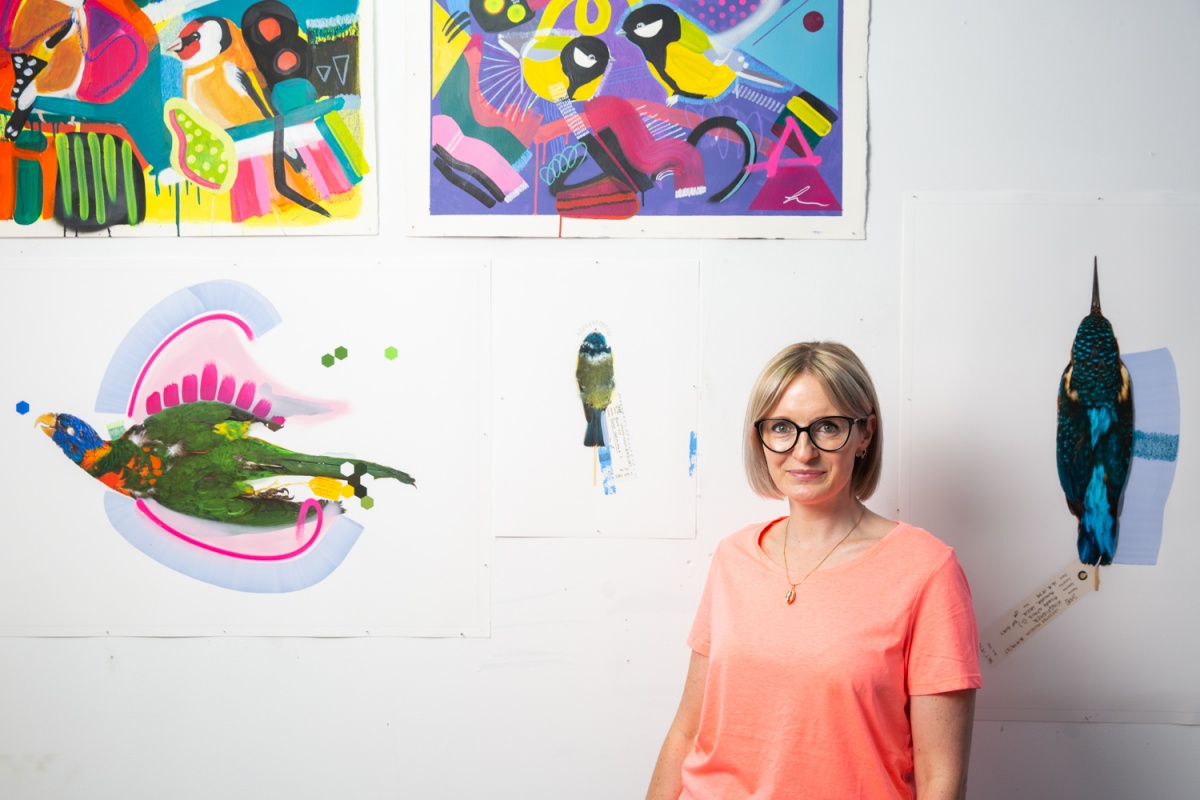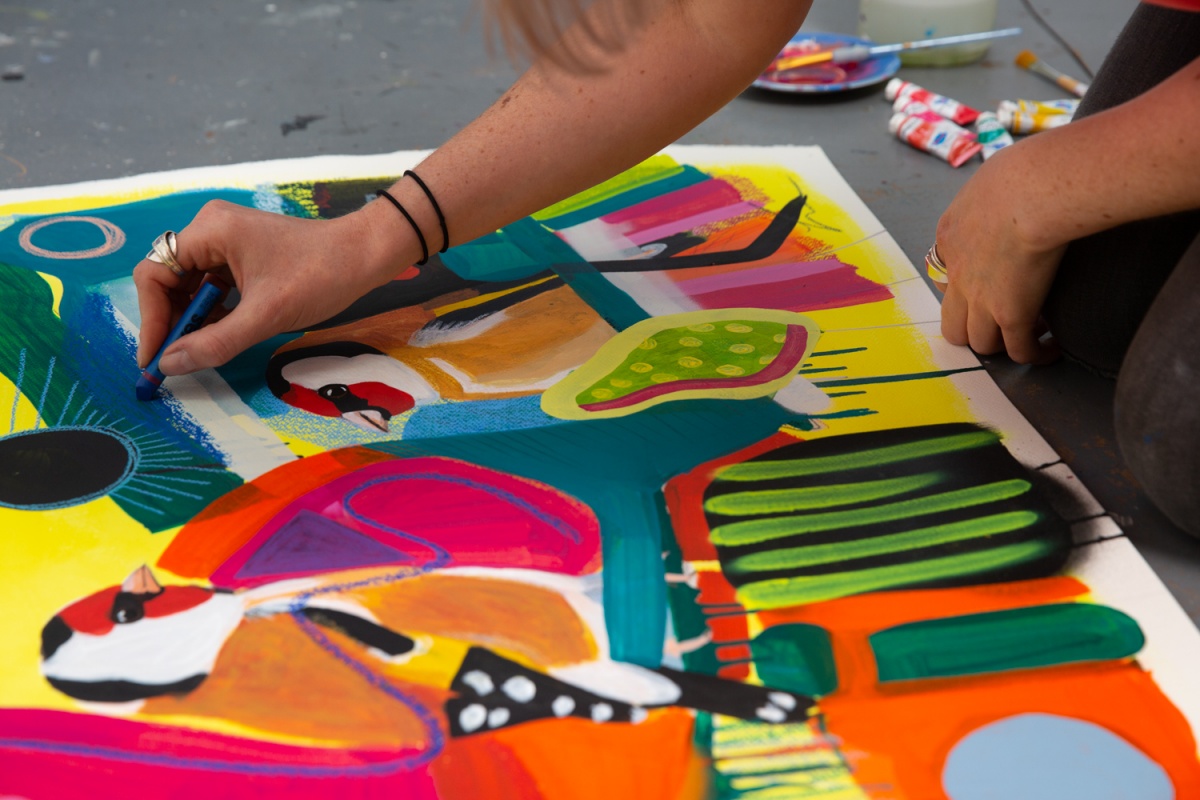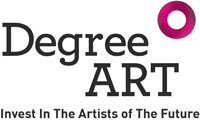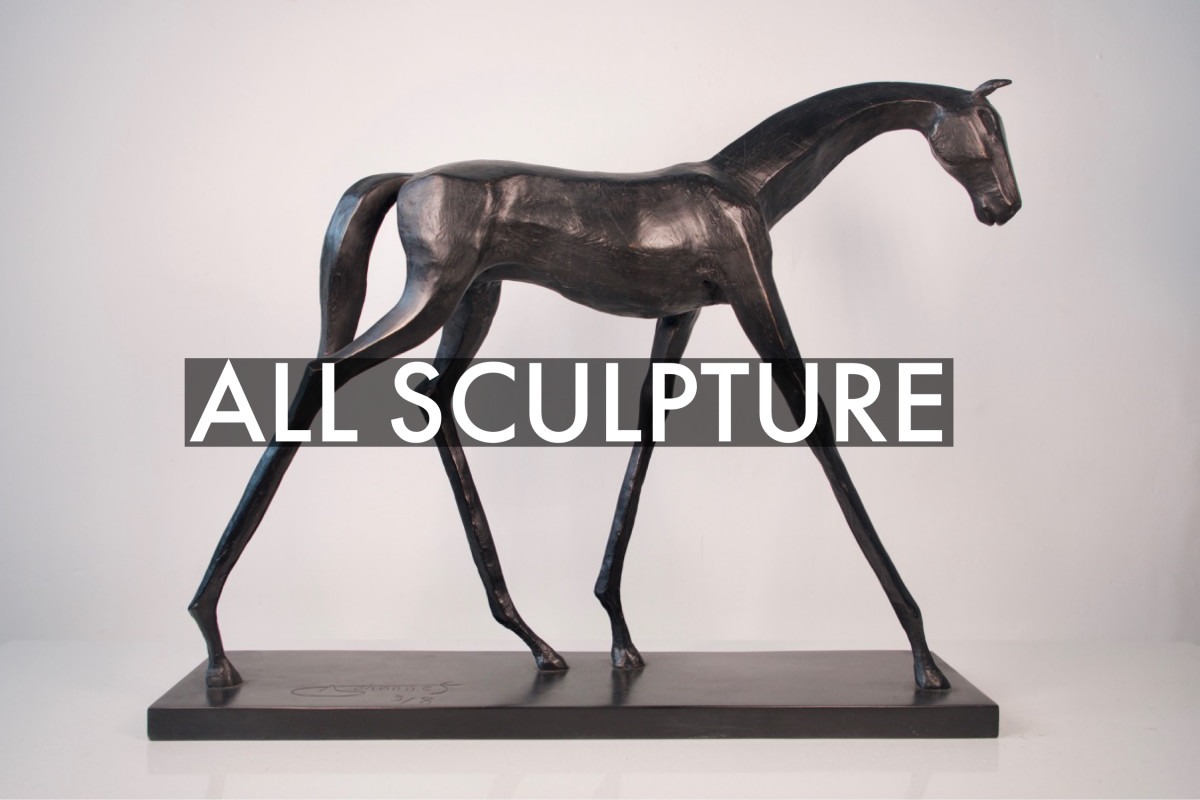Lucy Stevens is a British Contemporary artist whose work explores our relationship with the natural environment on a social and cultural level. She draws inspiration from ornithology, colour theory, and natural science collections. She is also an amateur birdwatcher. Her projects often include working in collaboration with experts in the natural world including scientists, museum curators, ornithologists, photographers, and musicians. She creates mixed media abstract portraits of birds on paper, and sound works developed from gathering field recordings from the rural environment.

1) Which art movement do you consider most influential on your practice?
During my degree I was fascinated with surrealism, the macabre and video art. I’m a horror film fan, so it makes sense to be drawn to the works of Douglas Gordon, Tony Oursler, Joel-Peter Witkin and David Lynch. After university I started to interview people with unusual hobbies including UFO spotting and pigeon fancying/racing. This has led me to where I am today as an amateur birdwatcher, making artwork primarily about birds, conservation and feeling more of an affinity with abstract expressionism and contemporary art.
2) Where do you go and when to make your best art?
My studio at StudionAme in Leicester at the weekend. The space is home to over 30 talented arts practitioners whose expertise range from ceramics, glass, painting, illustration, sculpture, jewellery and more. It also offers a generous arts community that is friendly and supportive. I don’t think I would have shown any of my artwork at art fairs if it wasn’t for the encouragement from the other studio members.
3) How do you describe your 'creative process'?
It depends what I’m creating. If it’s a mixed media piece, then that’s different to a soundscape or a digital illustration. I find that creating a soundscape is like telling a story, it needs to have a clear start, middle and end and when you’re collecting hours and hours of field recordings from rural environments, you have to be quite brutal in the edit. When creating a digital illustration, it can feel more like an administrative task (that isn’t necessarily a bad thing), purely because this tends to be a very structured process and quite often an outlet to interpret research through creative graphs and charts.
I work in an intuitive way in the studio using paint, pastel, spray paint, collage and monoprint onto paper or printed photographs. I listen to music on headphones to focus and block out any distractions. I have a table where I mix acrylic and household paint and a space where I keep my oil, wax pastels and a pile of paper for collage. My space is a bit messy, but I know where everything is and that allows me to get into a flow of working on more than one piece, usually up to 8 pieces at once. I’ll usually photograph the works at the end of each session and study them at home, sometimes adding marks using a basic app to work out the last few stages of a piece.
4) Which artist, living or deceased, is the greatest inspiration to you?
It’s really hard to select just one artist, but I do love Phyllida Barlow’s drawings and her vibrant and playful sculpture made from low-grade materials. I visited the Turner Contemporary in Margate when she had a solo show and explored her work for hours. I also love artworks by Marcus Coates, Olga Karlikova, Heather Day, Esther Tyson and there is a huge list of talented artists and taxidermy artists sharing their work across Instagram too. It is definitely a great place to discover new artists, especially during lockdown.
5) If you weren't an artist, what would you do?
I wanted to be a veterinary nurse when I was younger because I spent most of my time playing outdoors and rescuing stray rabbits or chicks that had fallen from nests and also burying dead animals and giving them a ceremony too, which sounds really odd! I’m not sure I would have been very good as a veterinary nurse as I’d get too attached to the animals and putting them to sleep would be absolutely heartbreaking.
6) What do you listen to for inspiration?
I listen to the birds whilst walking in the meadows near my home or if I can’t get out, I’ll open a window and try to identify the songs and calls. Birdsong is like learning a new language, the more you listen and identify species the better. I can get really rusty when I’m busy and don’t make time to tune in and listen. When I’m in the studio I listen to Bee One, First Aid Kit, Wolf Alice, Her Name is Calla, Rattle and lots more.
7) If you could own one artwork, and money was no object, which piece would you acquire?
I think I’d like to own an outdoor sculpture, maybe something huge in my garden by Louise Bourgeois or a 40ft puppy by Jeff Koons.
8) If your dream museum or collection owner came calling, which would it be?
It would be a dream come true for the Natural History Museum to acquire my artwork. I’d love to collaborate with the museum, the difficult part would be deciding which collection to work with, as there are so many departments and a wealth specimens.
9) What is your key piece of advice for artists embarking on a fine art or creative degree today?
Do not overthink everything. Just make a start and keep going. Do not get distracted by what others are doing or feel like you need to change your processes or style to match others. Do not be afraid of making mistakes, if you do, you’ll learn to cover these up like a pro. Listen to your gut.
10) What is your favorite book of all time (fiction or non fiction)?
I love books that are about identifying or organising nature and colours, like ‘Animal Vegetable Mineral’ published by the Wellcome Collection and ‘Werners Nomenclature of Colours’ by P Syme. These books are great for research to support my art practise and books that I will go back to again and again. I’m also trying to get more hygge into my life, which is a Danish and Norwegian saying for a mood of coziness, wellness and comfortable contentment with close family and friends.
11) If you could hang or place your artwork in one non traditional art setting, where would that be?
Anywhere with a forest or wide-open green space. I’ve been wanting to produce something sculptural or a sound sculpture for a while. Think Kielder Forest or Yorkshire Sculpture Park (these are two of my favourite places).
If it was a traditional setting, I’d say the Guggenheim. I visited when I was at university in 2003 when Matthew Barney was showing and thought that if I could show my work there then I would have made it as an artist.
12) What was the biggest lesson your university course or time studying taught you?
This biggest eureka moment came right after I finished installing my final piece for the degree show. I realised that it didn’t matter how the tutors scored my work and it didn’t matter what result I got for my degree; it was all down to two people’s opinion. And even though I respected my tutors, it didn’t have to define what I did and didn’t do as an artist in that moment of time or for the rest of my life.
13) And finally, if we were to fast forward 10 years, where would we find you?
Working as an artist full time, spilt between the studio at StudionAme and a studio at the bottom of my garden. Achieving a good balance of collaborating with museum collections and scientists from across the world, so lots of travelling, learning new techniques (I’d love to try sculpture), taking part in international fairs and exhibitions and getting a dog to remind me to exercise and take breaks.
Learn more about Lucy and discover her collection of artworks.













